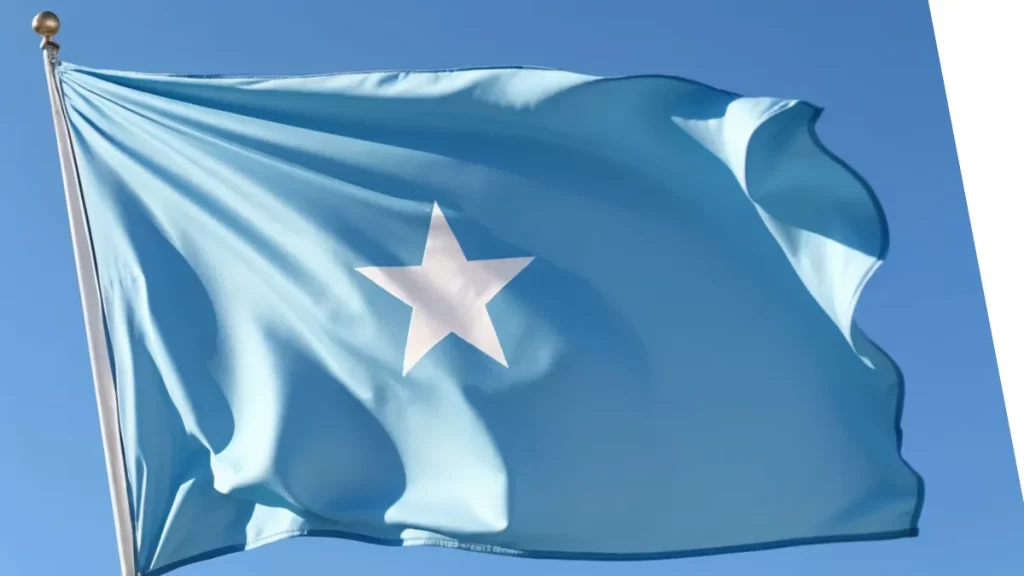The Somalia flag is more than just a piece of cloth. It tells a story of Unity, struggle, and hope. This flag, with its simple yet powerful design, holds deep meaning for the Somali people. In this article, we will explore the history, symbolism, and significance of the Somalia flag.
The Birth of the Somalia Flag
Historical Background
In the mid-19th century, the Horn of Africa was a land divided. Somalia was split among Ethiopia, France, Britain, and Italy. Each region had its rulers and its struggles. This division lasted until after World War II, when changes began to take shape. The former Italian Somalia was promised independence, and the British agreed to transfer their colony, Somaliland, to a united Somali state.
The Journey to Independence
The promise of independence brought hope to the Somali people. They yearned for a united nation where all Somalis could live together in peace. On October 12, 1954, the light blue flag with a white star was first raised. This was a symbol of the new beginning that was on the horizon.
Symbolism of the Somalia Flag

The White Star
The white star in the centre of the flag is more than just a design element. A Somali homeland is represented by each of its five points. These homelands include Djibouti, the Ogaden region in Ethiopia, the North Eastern Province in Kenya, and the former British and Italian Somaliland. The star is a symbol of Unity and hope for all Somalis, no matter where they live.
The Blue Background
The United Nations flag inspired the light blue background of the Somalia flag. This choice reflects the role the UN played in assisting Somalia towards independence. The blue also symbolizes the sky and the Indian Ocean, which borders Somalia. This colour is a reminder of the vast and beautiful land that the Somali people call home.
The Role of the United Nations

Assistance to Independence
The United Nations played a crucial role in Somalia’s journey to independence. After World War II, the UN helped to set up a trusteeship in Italian Somalia. This trusteeship was a stepping stone towards full independence. The blue in the flag is a nod to this important support.
International Recognition
On June 26, 1960, Somaliland officially adopted the Somalia flag. Just a few days later, on July 1, 1960, the former Italian Somalia also adopted the flag. This marked the unification of the two regions and the birth of the Somali Republic. The flag became a symbol of international recognition and a new chapter in Somalia’s history.
Also Read: Mexico Flag: Defend the Nation of The Symbols In The Flag
The Flag’s Official Adoption
Key Dates
The official adoption of the Somalia flag is tied to significant dates in the country’s history. On June 26, 1960, Somaliland celebrated its independence by raising the new flag. Just a few days later, the former Italian Somalia followed suit on July 1. These dates are now celebrated as national holidays in Somalia.
Celebrating Unity
The adoption of the flag was a moment of great pride for the Somali people. It symbolized the end of colonial rule and the beginning of a united and independent nation. The flag brought together Somalis from different regions under one symbol of hope and Unity.
The Impact of the Somalia Flag Today

A Symbol of Hope
Today, the Somalia flag continues to be a powerful symbol for Somalis around the world. It stands for their common goals, history, and culture. The flag is flown proudly on national holidays, during international events, and at Somali embassies around the world.
Challenges and Resilience
Somalia has faced many challenges since gaining independence. Civil war, political instability, and economic struggles have tested the nation’s resilience. Despite these challenges, the flag remains a symbol of the Somali people’s enduring hope and strength. It is a reminder that they are united in their quest for peace and prosperity.
Closing Thoughts
The Somalia flag is a powerful emblem of the nation’s history and aspirations. From its origins in a divided land to its role in a united and independent Somalia, the flag tells a story of hope, Unity, and resilience. Each time the light blue flag with the white star is raised, it serves as a reminder of the Somali people’s journey and their enduring spirit. The story behind the Somali flag helps us appreciate its significance and the deep connection it holds for the Somali people.
FAQs:
What does the white star on the Somalia flag represent?
The white star’s five points represent the Somali homelands: Djibouti, the Ogaden region in Ethiopia, the North Province in Kenya, and the former British and Italian Somaliland.
Why is the Somalia flag light blue?
The light blue background was inspired by the United Nations flag, reflecting the UN’s role in Somalia’s path to independence.
When was the Somalia flag first raised?
The Somalia flag was first officially raised on October 12, 1954.
When did Somaliland and former Italian Somalia adopt the flag?
Somaliland adopted the flag on June 26, 1960. The former Italian Somalia adopted it on July 1, 1960, marking the unification of the two regions.




